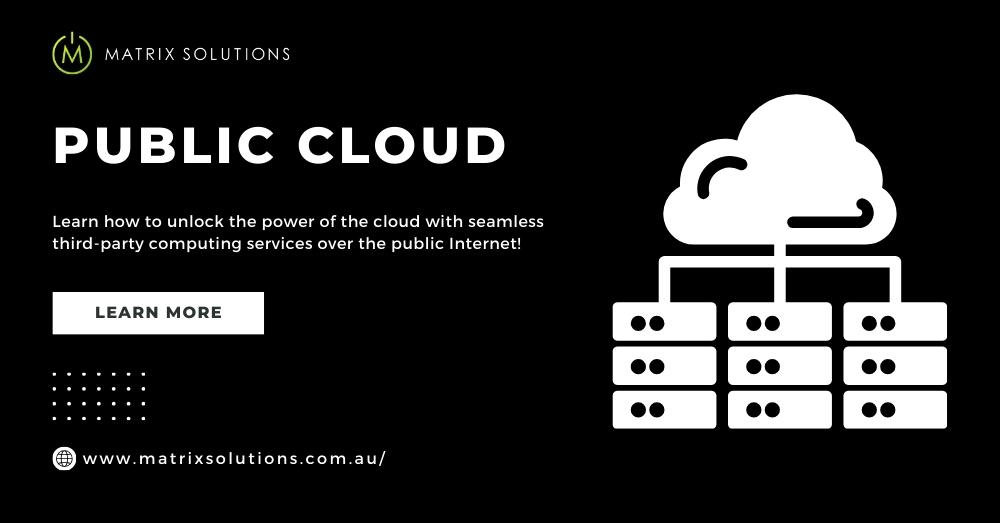A Public cloud is a managed cloud deployment model and computing service provided by third-party, public cloud service providers over the public internet. These services, such as servers, cloud storage, databases, networking, automation software, analytics, and applications, are accessible to public cloud users on a pay-as-you-go basis. Managed public cloud offers several benefits, such as flexibility, scalability, accessibility and reliability, making it a popular choice for individuals and businesses to offload their IT infrastructure and focus on their core activities.
Public cloud providers and adoption
Public cloud providers are typically owned and operated by large cloud service providers, i.e. Microsoft Azure, Amazon Web Services (AWS) and Google Cloud Platform (GCP). Businesses, individuals, and government agencies adopt public cloud solutions.
Categories of available public cloud services
The different categories of available public cloud managed services are:
- Software as a Service (SAAS)
- Platform as a Service (PAAS)
- Infrastructure as a Service (IAAS)
Characteristics of the public cloud
A Public cloud consists of the following key characteristics:
- Resource Pooling
- Pay-per-use pricing
- On-demand self-service
- Scalability and rapid elasticity
- Broad Network Access
- Measured Service
- Multi-tenancy and Accessibility
- Security
Public cloud infrastructure
The public cloud depends on a virtualised environment to extend a company’s physical IT infrastructure, allowing it to host a certain portion of its infrastructure and services on virtual services that are offsite and owned by a third party. It operates on a virtualised, scalable, and self-service model, allowing cloud customers to access and manage various public cloud resources and services.
Public cloud infrastructure consists of the following:
- Data centres
- Networks
- Operating systems
- Aut software
- Management tools
Advantages of public cloud computing
The benefits of public cloud computing are as follows:
Scalability
As per the need, you can easily and quickly adjust public cloud resources available to an application or service to meet changing demands. This flexibility will enable businesses to scale up or down per their needs efficiently.
Accessibility
Public cloud computing allows you to access cloud resources anywhere worldwide with an internet connection. This benefits remote employees or businesses who need to access their applications and data from multiple locations. Accessibility enhances flexibility and mobility, reduces cloud budget, and ease of management, making it a convenient choice for organisations and individuals.
Upfront Costs
Public cloud computing reduces upfront costs by eliminating the need to purchase and maintain hardware and software. It offers a pay-as-you-go pricing model, which means you only pay for the resources you use. This model eliminates significant upfront capital expenditures, making cloud computing more cost-effective and accessible for various individuals and organisations.
Reliability
Public cloud computing offers high reliability as it maintains redundant infrastructure, robust data centres and backup systems. This ensures users can access their data and applications with minimal downtime and disruptions, contributing to a more stable and dependable environment than on-premises solutions.
Challenges in Embracing Public Cloud Computing for Businesses
Security Concerns
Businesses and individuals are concerned about their data and application security when hosted in the cloud. When adopting public cloud services, companies may have several security concerns, such as data breaches, unauthorised access, data loss, corruption, and compliance with security regulations.
Loss of Control
While hosting in the cloud, organisations no longer have full control over their data and applications. The cloud provider has full control over the physical infrastructure, data security, compliance, operating system and the software stack. This can concern businesses that need to maintain high security and compliance.
Compliance and Regulations
Businesses must ensure that their use of cloud services aligns with the industry-specific and regional regulations, standards and legal requirements. Companies may need to comply with different constraints, such as Data protection laws, Industry regulations and Government regulations, which is a complex and time-consuming process.
Data Transfer and Latency
Companies may face challenges moving and accessing data between their location and the cloud. The distance between business and the cloud, the amount of traffic on the network, and the type of network connection can affect data transfer and latency. High latencies lead to delays in data processing, impacting the performance of applications and services.
Cost Management
Major Cloud providers often charge for cloud services and resources based on usage, performance, availability, location and features. This can make it difficult for businesses to predict and control cloud costs. Companies might face specific challenges with cost management, such as:
- Complexity of pricing
- Variability of usage
- Overprovisioning
- Hidden Costs
Public Cloud Security
Security is a major concern for enterprises due to the public cloud’s multi-tenant nature. It encompasses a range of challenges and strategies related to protecting data, applications, and infrastructure on public cloud platforms. Businesses might face security challenges such as data breaches, Account hijacking, Malware, DDOS attacks, etc.
Shared Responsibility
A cloud security framework defines the responsibilities of cloud service providers (CSPS) and their customers for protecting cloud environments. Under this model, cloud providers are responsible for cloud infrastructure security, while customers are responsible for securing their data, applications and configurations within the cloud environment.
Security Challenges
It refers to various obstacles and risks organisations might face, such as data breaches, unauthorised access, misconfigured security settings, and compliance with industry regulations.
Security Tools and Practices
Security Tools and Practices include using tools like firewalls, encryption, and access controls that comply with security practices such as regular audits and employee training to enhance the overall security posture in the cloud.
Public Cloud vs. Private Cloud
The Cloud service provided throughout the internet is known as the Public Cloud, whereas cloud service used only by one company or business is known as the Private Cloud. So, choose the best suitable for you between Public vs. Private Clouds.
Choosing Public Cloud Providers
It is one of the most crucial decisions. While selecting, evaluate various factors such as services offered, pricing, reliability, scalability, and compliance to make an informed decision about the provider that aligns with your business objectives and requirements.
Features Cloud Providers Should Have
Some of the key features cloud providers must have are:
- Data Security measures
- Scalability and reliability
- Wide range of services
- Cloud Computing Certification
- Cost transparency
- On-demand self-service
Why choose Public Cloud instances?
Selecting Public Cloud instances offers many benefits for businesses and individuals, such as Scalability, Cost-effectiveness, Flexibility, reliability, security and many more. It offloads your overall IT Infrastructure so that you can focus on other core sectors of your business or organisation.
FAQs
What is a public cloud solution?
A public cloud solution is a cloud computing service offered by third-party providers made available to the general public on the internet who wants to use or purchase them.
Why should one prefer public cloud over private cloud?
Choosing a public or private cloud depends on your specific needs and requirements. However, if you select the public cloud, it offers many benefits, such as Lower costs, Pay-per-use pricing, Global reach, Security and Compliance, access to advanced resources, etc.
What are the 3 public clouds?
The 3 main widely used Public clouds are:
- Amazon Web Services (AWS)
- Microsoft Azure
- Google Cloud Platform (GCP)




